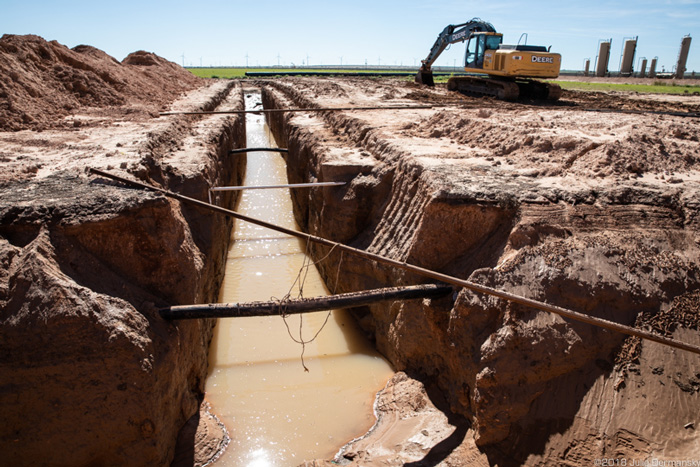AI and Fracking: 5 Key Impacts of the Horizon Data Center (2025 Insight)
Discover how the Horizon data center in West Texas merges AI and fracking, reshaping energy dynamics and raising environmental concerns.

Giant AI Data Center Rising in the Heart of America’s Fracking Boom
A massive new AI data center is under construction in West Texas, marking a significant convergence of artificial intelligence technology and the fossil fuel industry. Poolside, an AI coding startup, is partnering with CoreWeave, a cloud computing company specializing in GPU rentals, to develop a sprawling facility on over 500 acres of land in the Permian Basin—the most productive oil and gas field in the United States. This project, named Horizon, will generate approximately two gigawatts of computing power, roughly equivalent to the Hoover Dam’s electricity output, but uniquely powered by burning natural gas extracted directly from local hydraulic fracturing operations.
The Intersection of AI and Fracking
The Permian Basin in West Texas is synonymous with hydraulic fracturing, or fracking, a method that has driven the U.S. energy boom but also provoked environmental concerns, including groundwater contamination, increased seismic activity, and carbon emissions. The Horizon data center will tap into this abundant supply of fracked natural gas to self-generate electricity, effectively creating a closed-loop system where compute power and fuel sources are geographically and operationally coupled.
CoreWeave will supply access to more than 40,000 Nvidia AI GPUs, which are critical for running complex machine learning models, especially for AI applications like coding assistants, natural language processing, and video generation. Poolside’s decision to locate the facility directly in fracking country is driven by the proximity to cheap, plentiful energy, allowing for lower delivered energy costs and minimized grid transmission delays compared to data centers reliant on traditional power grids.
Environmental and Social Implications
While the AI sector often frames itself as a driver of innovation and sustainability, the Horizon project underscores a paradox of AI’s environmental footprint. Despite AI’s virtual nature, the physical infrastructure behind it consumes enormous amounts of energy, much of which currently derives from fossil fuels. Fast-tracked by a July 2025 executive order, which streamlined environmental permits and offered financial incentives to gas-powered AI data centers, projects like Horizon facilitate a resurgence in fossil fuel dependence even as the world wrestles with climate change.
Local communities face significant impacts due to this development. The construction involves bulldozing large tracts of Texas land, with potential consequences for local ecosystems and residential areas. There is also a risk of increased emissions and seismic activity related to intensified fracking operations near human settlements, raising concerns among environmental advocates and residents alike.
Industry Dynamics and Future Outlook
This project exemplifies a broader industry trend where AI companies are building data centers adjacent to fossil fuel production sites to secure reliable, cost-effective power. Louisiana and other states are expected to follow Texas’s playbook. By creating dedicated small-scale power grids linked directly to natural gas wells, these companies avoid competing with residential consumers on outdated electric grids.
The partnership between Poolside and CoreWeave highlights the growing importance of specialized hardware and infrastructure in the AI ecosystem. CoreWeave’s model of renting access to Nvidia GPUs is becoming a cornerstone of AI computing, driving demand for large-scale data centers that can meet exponential growth in AI workloads.
However, this growth comes with risks. There are questions about the sustainability of fossil fuel-based AI infrastructure and who will bear the cost if the AI-powered energy buildout slows or faces regulatory challenges. The environmental trade-offs of locking AI’s future to fossil fuels could complicate efforts to decarbonize both technology and energy sectors.
Visualizing the Horizon Project
Images related to the Horizon data center depict vast, cleared land in West Texas with construction activity underway, rows of cooling infrastructure, and large electric generation units reportedly powered by fracked gas. Corporate logos of Poolside and CoreWeave appear prominently in promotional materials, emphasizing their partnership and the deployment of thousands of Nvidia GPUs. Satellite and drone photos show the scale of the project, highlighting its footprint as nearly two-thirds the size of New York’s Central Park.
The Horizon data center project is a stark reminder of AI’s growing energy demands and the complex balance between technological progress and environmental responsibility. As AI continues to expand, so too will the infrastructure that powers it, with significant implications for energy policy, climate goals, and the communities hosting these digital titans.
Relevant Images to Illustrate the Story
- Aerial or satellite images of the Horizon data center construction site in West Texas, showing the scale of the land clearing and early infrastructure.
- Logos of Poolside and CoreWeave to identify the key companies driving the project.
- Photos or renders of Nvidia GPUs to represent the core computing technology powering the data center.
- Visuals of fracking operations in the Permian Basin to contextualize the energy source.
- Infographics comparing the facility’s computing power (2 gigawatts) to the Hoover Dam’s electricity capacity.
These images directly capture the essence of the intersection between AI and fossil fuel infrastructure emphasized in this story.


